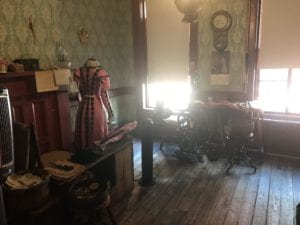This past summer (2018), APH student Erika Bentsen interned at the Tenement Museum in New York City. Below you’ll find Erika’s blog post about his experience.
—————————————————————————————————————————————————————
This past summer, I worked as a research and exhibit development fellow in the Tenement Museum’s Curatorial Department. The Tenement Museum, located in an original mid-nineteenth century tenement building on the Lower East Side of Manhattan, expertly narrates the stories of real people who lived there by using primary resources such as census records, newspaper articles, artifacts, and oral histories. Their mission is to make connections between immigrants, migrants, and refugees from the past to the present and to acknowledge how American society has been positively shaped by immigration.

Magistrate Court Record circa 1891 (Photo Courtesy: Erika Bentsen)
As part of the museum’s strategic plan, they aim to expand the stories that the museum tells about residents from the past. My research task was to comb through Magistrate Court Records, located at the New York City Municipal Archives, to find crimes committed by residents of 97 and 103 Orchard that could lead to further investigation. Once I identified residents, I used New York State Penal Codes as well as secondary sources about immigrant life at this time in order to contextualize their crimes. Additionally, I referenced the museum’s archives as well as census records to learn more about personal stories and familial connections.
Overall, the crimes committed by residents were byproducts of the cramped and oppressive living conditions they faced in the tenements. One common crime was “disorderly conduct,” a nebulous charge that was often used to target seemingly “unruly” immigrants, mostly men, who were apprehended on the streets. Other crimes included spousal abandonment, intoxication, sanitation violations, larceny, and fire code violations. Sanitation violations often occurred when tenants ran businesses, like groceries, from the ground floor apartments of 97 Orchard, or when tenants operated push carts on the crowded streets. Fire code violations occurred when residents used their fire escapes as exterior spaces to make their crowded and hot tenement apartments more livable.

The Levine family’s tenement apartment, which served as a garment factory in the early twentieth century. (Photo Courtesy: Erika Bentsen)
In addition to my research, I attended education department meetings and helped the collections department inventory two different period rooms and organize and catalog the artifacts. I learned about conservation techniques through this work and was able to handle nineteenth and early twentieth century collection pieces and used furnishing plans to “set the scene” of what a tenement apartment would have looked like at the time of its historical interpretation. I also did some sewing and maintenance projects on artifacts like clothing for preservation purposes. The museum was undergoing essential conservation work at the time and staff found hidden objects under the floorboards, including petrified mice, corn cobs, a medicine bottle, and a compact mirror, which I photographed to use in promotional materials.
This internship showed me the inner workings of a successful museum and how all departments collaborate to help visitors genuinely engage with the stories of the past and make meaningful connections to their personal lives and to modern American society.